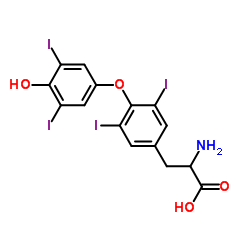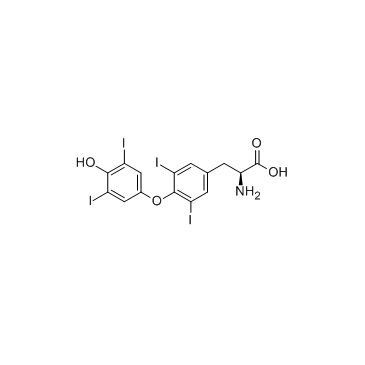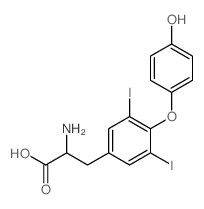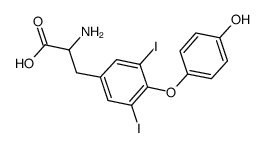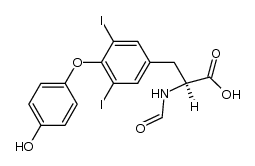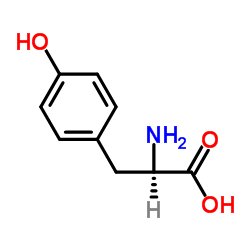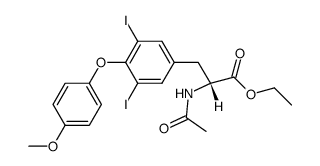Dextrothyroxine
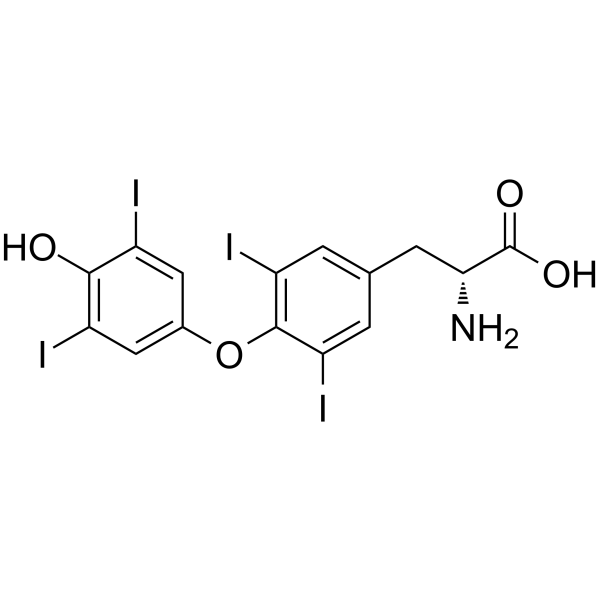
Dextrothyroxine structure
|
Common Name | Dextrothyroxine | ||
|---|---|---|---|---|
| CAS Number | 51-49-0 | Molecular Weight | 776.870 | |
| Density | 2.6±0.1 g/cm3 | Boiling Point | 576.3±50.0 °C at 760 mmHg | |
| Molecular Formula | C15H11I4NO4 | Melting Point | 225ºC | |
| MSDS | N/A | Flash Point | 302.3±30.1 °C | |
Use of DextrothyroxineD-Thyroxine (D-T4) is a thyroid hormone that can inhibit TSH secretion. D-Thyroxine can be used for the research of hypercholesterolemia[1][2]. |
| Name | D-thyroxine |
|---|---|
| Synonym | More Synonyms |
| Description | D-Thyroxine (D-T4) is a thyroid hormone that can inhibit TSH secretion. D-Thyroxine can be used for the research of hypercholesterolemia[1][2]. |
|---|---|
| Related Catalog | |
| References |
| Density | 2.6±0.1 g/cm3 |
|---|---|
| Boiling Point | 576.3±50.0 °C at 760 mmHg |
| Melting Point | 225ºC |
| Molecular Formula | C15H11I4NO4 |
| Molecular Weight | 776.870 |
| Flash Point | 302.3±30.1 °C |
| Exact Mass | 776.686646 |
| PSA | 92.78000 |
| LogP | 5.93 |
| Vapour Pressure | 0.0±1.7 mmHg at 25°C |
| Index of Refraction | 1.795 |
| Storage condition | 2-8°C |
Synonym:None Known Section 2 - COMPOSITION, INFORMATION ON INGREDIENTS
Risk Phrases: 20/21/22 Section 3 - HAZARDS IDENTIFICATION EMERGENCY OVERVIEW
Harmful by inhalation, in contact with skin and if swallowed.Light sensitive.The toxicological properties of this material have not been fully investigated. Potential Health Effects Eye: May cause eye irritation. Skin: May cause skin irritation. Ingestion: May cause irritation of the digestive tract. The toxicological properties of this substance have not been fully investigated. Inhalation: May cause respiratory tract irritation. The toxicological properties of this substance have not been fully investigated. Chronic: No information found. Section 4 - FIRST AID MEASURES Eyes: Immediately flush eyes with plenty of water for at least 15 minutes, occasionally lifting the upper and lower eyelids. Get medical aid. Skin: Get medical aid. Flush skin with plenty of water for at least 15 minutes while removing contaminated clothing and shoes. Wash clothing before reuse. Ingestion: Never give anything by mouth to an unconscious person. Get medical aid. Do NOT induce vomiting. If conscious and alert, rinse mouth and drink 2-4 cupfuls of milk or water. Inhalation: Remove from exposure and move to fresh air immediately. If not breathing, give artificial respiration. If breathing is difficult, give oxygen. Get medical aid. Notes to Physician: Section 5 - FIRE FIGHTING MEASURES General Information: As in any fire, wear a self-contained breathing apparatus in pressure-demand, MSHA/NIOSH (approved or equivalent), and full protective gear. During a fire, irritating and highly toxic gases may be generated by thermal decomposition or combustion. Runoff from fire control or dilution water may cause pollution. Extinguishing Media: In case of fire, use water, dry chemical, chemical foam, or alcohol-resistant foam. Use agent most appropriate to extinguish fire. Section 6 - ACCIDENTAL RELEASE MEASURES General Information: Use proper personal protective equipment as indicated in Section 8. Spills/Leaks: Vacuum or sweep up material and place into a suitable disposal container. Clean up spills immediately, observing precautions in the Protective Equipment section. Avoid generating dusty conditions. Provide ventilation. Section 7 - HANDLING and STORAGE Handling: Wash thoroughly after handling. Remove contaminated clothing and wash before reuse. Use with adequate ventilation. Minimize dust generation and accumulation. Avoid contact with eyes, skin, and clothing. Keep container tightly closed. Avoid ingestion and inhalation. Store protected from light. Storage: Keep container closed when not in use. Store in a tightly closed container. Store in a cool, dry, well-ventilated area away from incompatible substances. Hormones and antibiotics room. Store protected from light. Section 8 - EXPOSURE CONTROLS, PERSONAL PROTECTION Engineering Controls: Facilities storing or utilizing this material should be equipped with an eyewash facility and a safety shower. Use adequate ventilation to keep airborne concentrations low. Exposure Limits CAS# 51-49-0: Personal Protective Equipment Eyes: Wear appropriate protective eyeglasses or chemical safety goggles as described by OSHA's eye and face protection regulations in 29 CFR 1910.133 or European Standard EN166. Skin: Wear appropriate protective gloves and clothing to prevent skin exposure. Clothing: Wear appropriate protective clothing to prevent skin exposure. Respirators: Follow the OSHA respirator regulations found in 29 CFR 1910.134 or European Standard EN 149. Use a NIOSH/MSHA or European Standard EN 149 approved respirator if exposure limits are exceeded or if irritation or other symptoms are experienced. Section 9 - PHYSICAL AND CHEMICAL PROPERTIES Physical State: Solid Color: cream Odor: None reported. pH: Not available. Vapor Pressure: Not available. Viscosity: Not available. Boiling Point: Not available. Freezing/Melting Point: 225 deg C Autoignition Temperature: Not applicable. Flash Point: Not applicable. Explosion Limits, lower: Not available. Explosion Limits, upper: Not available. Decomposition Temperature: Solubility in water: insoluble Specific Gravity/Density: Molecular Formula: C15H11I4NO4 Molecular Weight: 776.86 Section 10 - STABILITY AND REACTIVITY Chemical Stability: Stable under normal temperatures and pressures. Conditions to Avoid: Incompatible materials, light, dust generation, excess heat, strong oxidants. Incompatibilities with Other Materials: Oxidizing agents, strong bases. Hazardous Decomposition Products: Nitrogen oxides, carbon monoxide, irritating and toxic fumes and gases, carbon dioxide, nitrogen, hydrogen iodide. Hazardous Polymerization: Has not been reported. Section 11 - TOXICOLOGICAL INFORMATION RTECS#: CAS# 51-49-0 unlisted. LD50/LC50: Not available. Carcinogenicity: D-Thyroxine - Not listed by ACGIH, IARC, or NTP. Section 12 - ECOLOGICAL INFORMATION Section 13 - DISPOSAL CONSIDERATIONS Dispose of in a manner consistent with federal, state, and local regulations. Section 14 - TRANSPORT INFORMATION IATA Not regulated as a hazardous material. IMO Not regulated as a hazardous material. RID/ADR Not regulated as a hazardous material. Section 15 - REGULATORY INFORMATION European/International Regulations European Labeling in Accordance with EC Directives Hazard Symbols: XN Risk Phrases: R 20/21/22 Harmful by inhalation, in contact with skin and if swallowed. Safety Phrases: S 24/25 Avoid contact with skin and eyes. S 28A After contact with skin, wash immediately with plenty of water. S 37 Wear suitable gloves. S 45 In case of accident or if you feel unwell, seek medical advice immediately (show the label where possible). WGK (Water Danger/Protection) CAS# 51-49-0: No information available. Canada None of the chemicals in this product are listed on the DSL/NDSL list. CAS# 51-49-0 is not listed on Canada's Ingredient Disclosure List. US FEDERAL TSCA CAS# 51-49-0 is not listed on the TSCA inventory. It is for research and development use only. SECTION 16 - ADDITIONAL INFORMATION N/A |
| Hazard Codes | Xn:Harmful; |
|---|---|
| Risk Phrases | R20/21/22 |
| Safety Phrases | S24/25 |
| WGK Germany | 3 |
| HS Code | 2922509090 |
|
~% 
Dextrothyroxine CAS#:51-49-0 |
| Literature: BOARD OF REGENTS, THE UNIVERSITY OF TEXAS SYSTEM; ARMSTRONG, Daniel, W.; PING, Sun; BREITBACH, Zachary, S.; WANG, Chunlei Patent: WO2010/148191 A2, 2010 ; Location in patent: Page/Page column 45-49; 61 ; |
|
~% 
Dextrothyroxine CAS#:51-49-0 |
| Literature: Harington Biochemical Journal, 1928 , vol. 22, p. 1433 |
|
~% 
Dextrothyroxine CAS#:51-49-0 |
| Literature: Harington Biochemical Journal, 1928 , vol. 22, p. 1433 |
|
~% 
Dextrothyroxine CAS#:51-49-0 |
| Literature: Harington Biochemical Journal, 1928 , vol. 22, p. 1433 |
|
~% 
Dextrothyroxine CAS#:51-49-0 |
| Literature: Harington Biochemical Journal, 1928 , vol. 22, p. 1433 |
|
~% 
Dextrothyroxine CAS#:51-49-0 |
| Literature: Pitt Rivers; Lerman J. Endocrin., 1946 , vol. 5, p. 223,225 |
|
~% 
Dextrothyroxine CAS#:51-49-0 |
| Literature: Elks; Waller Journal of the Chemical Society, 1952 , p. 2366,2369 |
|
~% 
Dextrothyroxine CAS#:51-49-0 |
| Literature: Elks; Waller Journal of the Chemical Society, 1952 , p. 2366,2369 |
|
~% 
Dextrothyroxine CAS#:51-49-0 |
| Literature: Pitt Rivers; Lerman J. Endocrin., 1946 , vol. 5, p. 223,225 |
| HS Code | 2922509090 |
|---|---|
| Summary | 2922509090. other amino-alcohol-phenols, amino-acid-phenols and other amino-compounds with oxygen function. VAT:17.0%. Tax rebate rate:13.0%. . MFN tariff:6.5%. General tariff:30.0% |
|
Design of mechanism-based inhibitors of transthyretin amyloidosis: studies with biphenyl ethers and new structural templates.
J. Med. Chem. 50 , 5589-99, (2007) Transthyretin (TTR), a tetrameric thyroxine (T4) carrier protein, is associated with a variety of amyloid diseases. In this study, we explore the potential of biphenyl ethers (BPE), which are shown to... |
|
|
Maintenance of brain thyroid hormone level during peripheral hypothyroid condition in adult rat.
Life Sci. 79(15) , 1450-5, (2006) Thyroid hormones are essential for normal functioning of adult mammalian brain. The present investigation deals with the understanding of the time course of thyroid hormone homeostasis in adult rat br... |
|
|
Dextrothyroxine in the treatment of generalized thyroid hormone resistance in a boy homozygous for a defect in the T3 receptor.
Thyroid 2(1) , 15-9, (1992) The dextroisomer of thyroxine (D-T4) has been shown to have suppressive effects on pituitary TSH secretion in euthyroid individuals and patients with mild thyroid hormone resistance. We treated a 3-ye... |
| EINECS 200-102-7 |
| (2R)-2-amino-3-[4-(4-hydroxy-3,5-diiodophenoxy)-3,5-diiodophenyl]propanoic acid |
| (R)-2-Amino-3-(4-(4-hydroxy-3,5-diiodophenoxy)-3,5-diiodophenyl)propanoic acid |
| D-Thyroxine |
| MFCD00063056 |
| Choloxin |
| Thyroxine |
| 3,3′,5,5″-Tetraiodo-D-thyronine |
| D-Tyrosine, O-(4-hydroxy-3,5-diiodophenyl)-3,5-diiodo- |
| O-(4-Hydroxy-3,5-diiodophenyl)-3,5-diiodo-D-tyrosine |
